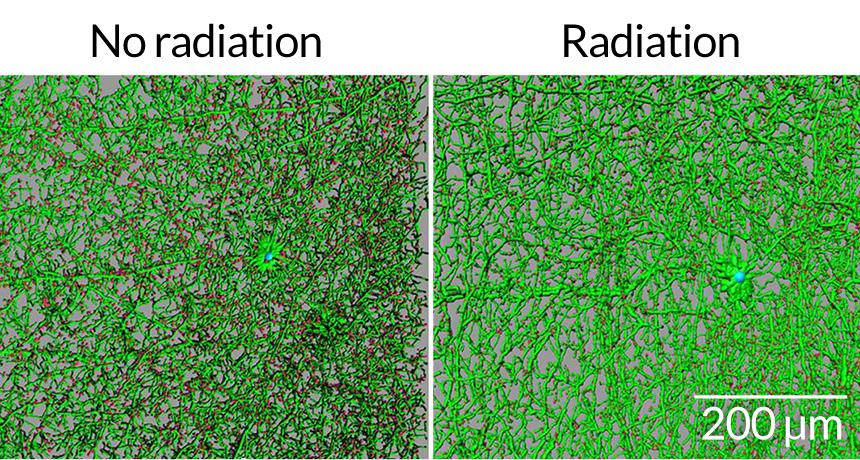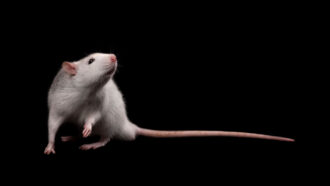Trip to Mars could damage astronauts’ brains
In mouse experiments, ‘space’ radiation caused memory, learning woes

Mice data suggest that astronauts could suffer brain damage on the long trip to and from Mars. After being exposed to radiation, parts of nerve cells (green) in the brains of mice were shorter (right digital image) — and branched less — than in unexposed mice (left).
V. PARIHAR ET AL/SCIENCE ADVANCES 2015
Particles zipping through space could be the wrong stuff for Mars astronauts.
A study using mice found these high-energy particles slice through the brain. They pruned back connections linking brain cells. This left the animals with memory and learning problems. The study’s authors now worry that astronauts could suffer similar effects on long missions outside Earth’s protective atmosphere. One example: traveling to Mars.
The new findings are “worrisome, very worrisome,” says M. Kerry O’Banion. As a neuroscientist he studies how the brain works. O-Banion works at the University of Rochester Medical Center in New York.
The explosion of massive stars creates cosmic rays. This energetic radiation consists of electrically charged particles. Traveling through space at nearly the speed of light, theis radiation would bombard a spacecraft and its astronauts. For how long? Well, a human mission to Mars could last between one and three years, the National Aeronautics and Space Administration estimates.
Charles Limoli works at the University of California, Irvine. For his team’s new study, the scientists beamed mice with high-energy charged particles. The idea was to simulate cosmic rays in space.
Six weeks later, the mice showed memory problems. They had a harder time recognizing new toys than did unzapped mice. They also did a poorer job of remembering where a toy had been. Details appeared May 1 in Science Advances.
Visible brain damage also showed up. The radiation shortened the complex branches on nerve cells that receive messages. It also left these brain cells with fewer branches, the team found. “We weren’t expecting such dramatic effects from these charged particles,” says Limoli.
Translating the findings to people
These findings suggest Mars astronauts, too, might suffer brain problems. And such effects could emerge while they were still in space. “Over the course of a long-term mission, this may become very problematic,” Limoli says. It could affect how well people perform on missions, including how quickly and how well they make decisions. Brain impacts also might persist even after they got back home.
Translating these data to people, however, is difficult, O’Banion says. “There are big differences in the way the animals are exposed to the radiation versus how astronauts are,” he points out. Space also holds a more complex mixture of particles than those in the test beam. The doses differ too. So a lot remains unknown about how the human body and brain will respond to such radiation, he says.
Still, Limoli’s team observes, “Our data indicate an unexpected and unique susceptibility of the [brain] to space radiation.” And this argues that space radiation could impair the ability of astronauts to perform critical tasks, the scientists say.
NASA wants to send astronauts to Mars by the 2030s. Learning more about cosmic rays may help scientists create better ways to protect those astronauts. Adding shielding to a spacecraft is one solution. However, shielding adds weight. And that makes a spacecraft more expensive and more difficult to launch.
Power Words
(for more about Power Words, click here)
astronaut People trained to travel into space for research and exploration.
atom The basic unit of a chemical element. Atoms are made up of a dense nucleus that contains positively charged protons and neutrally charged neutrons. The nucleus is orbited by a cloud of negatively charged electrons.
cognitive A term that relates to mental activities, such as thinking, learning, remembering and solving puzzles.
cosmic An adjective that refers to the cosmos — the universe and everything within it.
cosmic rays Very high-energy particles, mostly protons, that bombard Earth from all directions. These particles mostly originate outside our solar system. They are equivalent to the nucleus of an atom. They travel through space at high rates of speed (often close to the speed of light).
Mars The fourth planet from the sun, just one planet out from Earth. Like Earth, it has seasons and moisture. But its diameter is only about half as big as Earth’s.
National Aeronautics and Space Administration (NASA) Created in 1958, this U.S. agency has become a leader in space research and in stimulating public interest in space exploration. It was through NASA that the United States sent people into orbit and ultimately to the moon. It has also sent research craft to study planets and other celestial objects in our solar system.
neuroscience Science that deals with the structure or function of the brain and other parts of the nervous system. Researchers in this field are known as neuroscientists.
nucleus Plural is nuclei. (in physics) The central core of an atom, containing most of its mass.
particle A minute amount of something.
proton A subatomic particle that is one of the basic building blocks of the atoms that make up matter. Protons belong to the family of particles known as hadrons.
star Thebasic building block from which galaxies are made. Stars develop when gravity compacts clouds of gas. When they become dense enough to sustain nuclear-fusion reactions, stars will emit light and sometimes other forms of electromagnetic radiation. The sun is our closest star.







